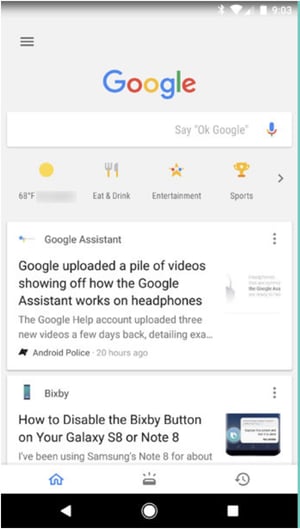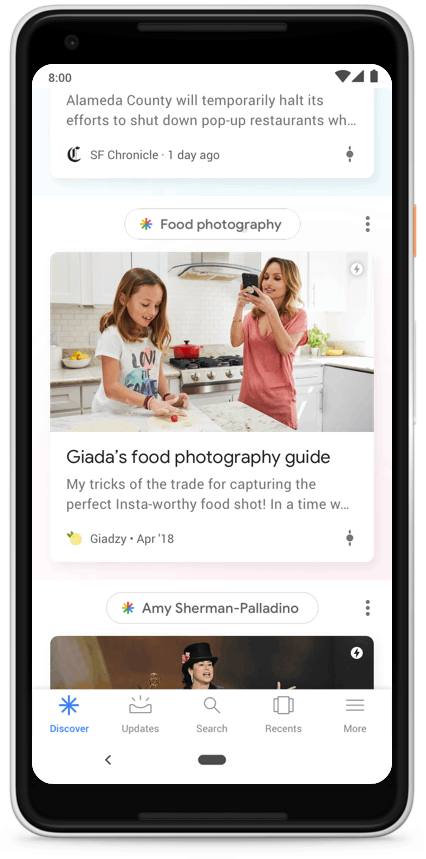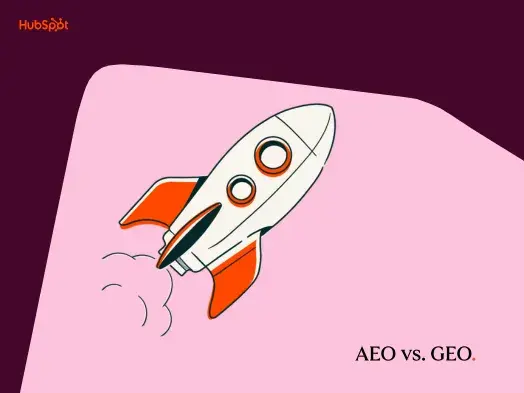But, despite Google Discover's effectiveness in pulling in mobile traffic, a lot of marketers still don't know what it is or how it can be leveraged in the online marketing world.
In this blog post, I'll explain what Google Discover is, why marketers need to know about it, and how you can increase the chances of your content getting highlighted on the platform.
After the Google app's feed feature -- which also gave users recommendations based on past searches -- reached 800 million monthly active users, the tech giant decided to revamp and rebrand it into Google Discover.
The Google Discover launch was part of a bigger initiative that aimed to identify ways that the company could improve its overall platform, and online search experiences, in the long-term. During the initiative, Google's overall platform began a series of updates that correlated with major shifts in the company's way of thinking about user experiences. These updates impacted Search, the Google app, and its recommendation feed.
Prior to the Google Discover rebrand, the Google app's original feed had a more text-based layout which primarily presented headlines, meta descriptions, and occasional photos to users. The design was quite similar to Google's desktop search result page format but with content recommendations instead of results.
To give you an idea of what the feed looked like, I dug up an old screenshot:

Source: ComputerWorld
When the feed was rebranded as Google Discover, it was re-designed with a more visual, customizable, and user-friendly format.
Google Discover also embraces a broader scope of online content than the Google feed did. Rather than recommending mostly news and recently published content, Google says that Discover pulls in a mix of news and evergreen content, such as photos, videos, recipes, and how-tos.
Here's what the current Google Discover design looks like:

Source: Google
Aside from improving on the variety of online visuals and content topics, Discover's platform also allows users to customize their experience. Each content recommendation shown has a specific header topic associated with it. For example, if you're looking for a lot of technology topics with Google Search, you might see headlines like "artificial intelligence" or "autonomous cars" associated with Google Discover recommendations.
When users are interested in the content they see, they can view it, tap the header to see similar content, or "follow" the topic so similar posts will show up on their Discover feed in the future.
If users no longer wish to follow a topic, they can simply tap the "More" button in their Google app, then tap "Your Data in Search" to see the topics their search results have generated. From there, they can follow or unfollow topics that Google algorithms have identified in their search query history.
Why Google Discover is Important
Think a feature that's only exclusive to Google's app isn't worth worrying about? Think again. Websites are already seeing the mobile benefits of Discover.
One example of a publisher that's benefiting from Google Discover is Vogue, which saw more traffic come from Google Discover than Google Search in October 2019.
Condé Nast, which owns Vogue and a handful of other notable publications, also reports that Discover is now responsible for 20% of its U.S. sites' Google-based traffic.
Aside from all the positive data, Google Discover is symbolic of where the internet, search engines, and most other online platforms are going. Engaging online content is getting more visual, personalized, and mobile-optimized.
Now and in the future, the best way to stand out or gain attention against a huge pool of similar websites is to publish blog pieces, articles, videos, images, or graphics that embrace the online trends that Google Discover is already algorithmically promoting.
Although Google Discover seems pretty beneficial, the feature is still relatively new, only app-based, and isn't a replacement for Google search.
While I don't encourage you to drop your entire Google Search strategy to focus on Discover, a few tactics that increase your chances of landing on Discover will also optimize your site for SEO at the same time.
To help you learn more about optimizing your site for Google Discover, I did some research and spoke to HubSpot Senior SEO Strategist Braden Becker to learn more about this platform.
Here are six tips that will boost your website's online experience, potentially improve search rankings, and increase your chances of landing on Google Discover.
1. Create and link meaningful pieces of web content around overarching topics.
Beyond all other tactics, Google says content creators should focus on what they do best: creating content that people will enjoy.
"Discover content is algorithmically ranked by what Google thinks a user would find most interesting. Content ranking is powered by the strength of the match between an article's content and a user's interests," advises a Google Support post.
HubSpot Senior SEO Strategist Braden Becker also says that one of the most important things you can do to get on Google Discover is to create multiple quality pieces of content related to overarching topics. Then, internally link them together.
"The main thing content creators need to remember about Google Discover is that it depends heavily on a user's past search behavior. This means it has the potential to surface a lot of content that's similar in subject matter to the content the user has already consumed," Becker explains.
"Creating multiple types of content on a related topic, and linking between these pages, is a great way to tell Google that this content is all connected," Becker advises. "That way, when a user clicks through to page A in normal organic results, they're more likely to find page B in their Discover feed."
Aside from increasing your chances of getting on Google Discover, internal linking will also be beneficial to your SEO.
At HubSpot, we embrace internal linking and quality topic coverage with our Pillar page strategy. First, we identify and write multiple specific articles about a broad topic, like Instagram. Then we create a long-form blog post about that same topic, often called a Pillar page or an Ultimate Guide.
When we internally link blog posts with similar overarching topics together, a user who wants to read up on something like Instagram can click through one blog post to multiple other blog posts about it in one sitting. This is great for the user experience, keeps our readers informed and engaged, and can boost SEO rankings for certain topics and keywords.
2. Include and optimize photos whenever possible.
Aside from creating and interconnecting quality content, Google says the next best thing you can do is add and optimize high-quality photos to your content or website.
Along with videos, Discover also makes content more appealing by showing large photos along with text descriptions. Even in text-based posts, you'll want to include visually appealing or informative photos that can capture a user's attention.
To optimize them for both Discover and Search algorithms, be sure to add alternate text and compress the files so they don't slow page-load speeds or harm your search ranking.
Need help with this step? Here's a great guide to photo optimization.
3. Post more videos.
Google Discover is highly visual and aims to help people get lost in content recommendations that are interesting to them. Because online video viewing is growing with each new generation, it's no surprise that Google Discover and Google search algorithms are favoring this type of content.
Because Google Discover emphasizes video, as well as a mix of evergreen and recent content, you should experiment with different types of video posts like tutorials, demos, interviews with thought leaders, or even short videos that inform viewers of a new trend in your industry.
Regardless of what you do, embracing video can't hurt your Google Discover or overall brand marketing strategy. After all, more and more people prefer to learn about brands through video.
If you're worried that you don't have time or resources to create a video strategy, fear not! In 2019, you don't need a camera crew or a huge budget to afford recording tools and editing software. Here's a great guide to filming an affordable and low-lift marketing video.
4. Create a mix of trendy and evergreen content.
Google has publicly posted that Google Discover will show audiences a mix of new and evergreen content. This gives users well-rounded experiences where they can catch up on important or time-sensitive trends while still gaining value or entertainment from more evergreen tips, videos, or photos.
Aside from Google Discover, putting out a mix of trend-related and evergreen content will also help boost your brand's strength as a content creator.
As the HubSpot Blog's Audience Growth Writer, I've seen that you can gain great SEO traffic, shareability, and engagement on your website when combining newsy and evergreen topics in your content strategy. Not only will your audiences recognize that you are in-the-know of your field of industry, but they'll also use your site as a resource for both time-sensitive information and foundational tips.
5. Follow Google News guidelines.
Google says that stories and content shown on Discover must follow Google News guidelines and policies. Google News requirements include publishing original content, keeping ads around the content to a minimum, and writing transparently so a reader can easily understand who wrote the piece, publish dates, where outside sources were used, and other important credibility-related factors. Here's a full list of Google News policies.
6. Optimize your site and content for mobile devices.
If you haven't already, you'll want to make sure you're posting content on a site that's easy to navigate and looks visually pleasing on mobile devices. If and when people find your content on Google Discover, they'll click into it from a mobile device. If the content isn't functional or easy to consume, they might exit your page quickly.
While it's not clear if Google Discover algorithms favor mobile-optimized sites, Google search algorithms have been rewarding mobile content since 2015. While a mobile-optimized site will boost your search ranking, and thus improve your credibility in the eyes of Google, it will also make your site more seamless and engaging to those who enter via Google Discover.
Landing on Google DIscover and Search Results
Ultimately, Google Discover and Google Search are trying to do one similar thing: offer up quality content that gives readers a seamless experience that matches what they're interested in or searching for.
Because of this, you should always focus on creating a solid and informative experience for your audience. While strong editorial judgment will help you create intriguing content, SEO strategies can also help you gain credibility in the eyes of Google algorithms. Both of these strategies can heighten your search rankings while also increasing your chances of landing on Google Discover.
If you've practiced even basic SEO strategies on your blog or website, you'll notice that optimizing your website for Google Discover and SERPs can be like killing two birds with one stone. Even if you don't land on Discover feeds immediately, this approach will help you embrace a new breed of online content and traditional SEO strategies at the same time.
Want to learn even more about how to rank on Google search result pages? We've got you covered. Check out our Ultimate Guide to SEO in 2019.
SEO







.png)




.jpg)